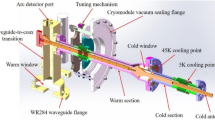Abstract
The Shanghai high-repetition-rate XFEL and extreme light facility (SHINE) under construction is designed to be one of the most advanced free electron laser (FEL) facilities in the world. The main part of the SHINE facility is an 8 GeV superconducting Linac operating in continuous wave (CW) mode. The Linac consists of seventy-five 1.3 GHz and two 3.9 GHz cryomodules. Based on the design and experience of 3.9 GHz cavities in the European X-ray free electron laser (E-XFEL) and the Linac coherent light source-II (LCLS-II) projects, we optimize the SHINE 3.9 GHz cavity design to adapt it for CW mode operation. In this paper, we present a particular redesign of the end group for the SHINE 3.9 GHz superconducting cavity that includes a redesign of the end cell and beam pipe to shift away the potentially troublesome lowest high-order modes (HOMs), a modification of the main coupler antenna, and a tuning of the HOM notch filter to meet the cavity requirements. RF losses calculations on the HOM coupler antennas show that the overheating on the inner conductor at the operating mode is diminished significantly. Furthermore, we have also studied the HOMs to ensure there are no dangerously trapped modes in the optimized cavity design.














Similar content being viewed by others
References
Z.Y. Zhu, Z.T. Zhao, D. Wang et al., SCLF: an 8-GeV CW SCRF linac-based X-ray FEL facility in Shanghai, in Proceedings of the FEL2017, Santa Fe, NM, USA (2017), p. 20. https://doi.org/10.18429/jacow-fel2017-mop055
Z.T. Zhao, C. Feng, K.Q. Zhang, Two-stage EEHG for coherent hard X-ray generation based on a superconducting linac. Nucl. Sci. Tech. 28, 117 (2017). https://doi.org/10.1007/s41365-017-0258-z
C. Feng, H.X. Deng, Review of fully coherent free-electron lasers. Nucl. Sci. Tech. 29, 160 (2018). https://doi.org/10.1007/s41365-018-0490-1
K. Flöttmann, T. Limberg, P. Piot, Generation of Ultrashort Electron Bunches by cancellation of nonlinear distortions in the longitudinal phase space. TESLA-FEL-2001-06 https://flash.desy.de/sites2009/site_vuvfel/content/e403/e1642/e772/e773/infoboxContent779fel2001-06.pdf
N. Solyak, I. Gonin, H. Edwards et al., Development of the third harmonic SC cavity at Fermilab. Proc. IEEE Particle Accel. Conf. 2, 1213–1215 (2003). https://doi.org/10.1109/pac.2003.1289656
M. Zhang, Linac Requirement. SHINE-AC-SCL-PHY-PR-0001
E. Plönjes, B. Faatz, M. Kuhlmann et al., FLASH2: Operation, beamlines, and photon diagnostics. AIP Conf. Proc. 1741, 020008 (2016). https://doi.org/10.1063/1.4952787
W.F.O. Müller, J. Sekutowicz, R. Wanzenberg, et al., A Design of a 3rd Harmonic Cavity for the TTF 2 Photoinjector. TESLA-FEL 2002-05 https://flash.desy.de/sites2009/site_vuvfel/content/e403/e1642/e750/e751/infoboxContent754/fel2002-05.pdf
P. Pierini, M. Bertucci, A. Bosotti, et al., Fabrication and vertical test experience of the European X-ray Free Electron Laser 3.9 GHz superconducting cavities. Phys. Rev.Accel. Beams 20, 042006 (2017). https://doi.org/10.1103/PhysRevAccelBeams.20.042006
M. Altarelli, The European X-ray free-electron laser facility in Hamburg. Nucl. Instrum. Meth. B. 269(24), 2845–2849 (2011). https://doi.org/10.1016/j.nimb.2011.04.034
A. Lunin, I.V. Gonin, T.N. Khabiboulline, et al., Redesign of the End Group in the 3.9 GHz LCLS-II Cavity, in Proceeding of LINAC2016, East Lansing, MI, USA, MOPLR007, pp. 145-148, https://doi.org/10.18429/JACoW-LINAC2016-MOPLR007
T. Khabiboulline, C. Cooper, N. Dhanaraj et al., 3.9 GHz superconducting accelerating 9-cell cavity vertical test results. IEEE Particle Accel. Conf. (PAC). Albuquerque, NM 2007, 2295–2297 (2007). https://doi.org/10.1109/PAC.2007.4441228
T. Arkan, P. Bauer, L. Bellantoni, et al., Development of the superconducting 3.9 GHz accelerating cavity at Fermilab. Proceedings of the 2005 Particle Accelerator Conference, Knoxville, TN, USA, 2005, pp. 3825-3827. https://doi.org/10.1109/PAC.2005.1591636
T. Khabiboulline, M. Awida, I. Gonin, et al., Modification of 3rd harmonic cavity for CW operation in LCLS-II accelerator. in Proceedings of NAPAC2016, WEPOB27. http://accelconf.web.cern.ch/napac2016/papers/wepob27.pdf
J.F. Chen, M. Moretti, P. Pierini, et al., Improvements of buildcavity code. SRF2015, THPB006, https://accelconf.web.cern.ch/SRF2015/papers/thpb006.pdf
Buildcavity v1.4.3, http://wwwsrf.mi.infn.it/Members/pierini
L. Merminga, J. Delayen, On the optimization of Qext under heavy beam loading and in the presence of microphonics. CEBAF TN-96-022, May 1996. https://www.jlab.org/uspas11/MISC/Beam%20loading%20TN.pdf
P.P. Gong, Y.B. Zhao, H.T. Hou et al. Front-end frequency conversion module design for harmonic RF system in SSRF. Nucl Tech., 42: 010101 (2019). (in Chinese) https://doi.org/10.11889/j.0253-3219.2019.hjs.42.010101
CST-computer Simulation Technology,http://www.cst.com
A. Lunin, T. Khabiboulline, N. Solyak, et al., Resonant excitation of high order modes in the 3.9 GHz cavity of the Linac Coherent Light Source. Phys. Rev. Accel. Beams 21, 022001 (2018). https://doi.org/10.1103/PhysRevAccelBeams.21.022001
P. Zhang, N. Baboi, R.M. Jones, Eigenmode simulations of third harmonic superconducting accelerating cavities for FLASH and the European XFEL. arXiv:1206.2782
P. Emma, J. Frisch, Z. Huang, et al., Linear Accelerator Design For The LCLS-II FEL Facility. in Proceedings of FEL2014, THP025. https://accelconf.web.cern.ch/FEL2014/papers/thp025.pdf
T.N. Khabiboulline, A. Lunin, G.R. Romanov, Multipacting in the LCLS-II 3.9 GHz HOM coupler. TD-17-002. https://web.fnal.gov/organization/TDNotes/Shared%20Documents/2017%20Tech%20Notes/TD-17-002.pdf
Acknowledgements
The authors would like to thank Paolo Pierini at ESS and Carlo Pagani at INFN-LASA for pre-reviewing the RF design. We are also grateful to Meng Zhang at SARI for discussing the physics parameters in the SHINE Linac and to Hongjuan Zheng at IHEP for discussing the HOM-related issues.
Author information
Authors and Affiliations
Corresponding author
Additional information
This work was partially supported by the National Key Research and Development Program of China (No. 2016YFA0401900) and the Shanghai Municipal Science and Technology Major Project (No. 2017SHZDZX02).
Rights and permissions
About this article
Cite this article
Zhang, YX., Chen, JF. & Wang, D. RF design optimization for the SHINE 3.9 GHz cavity. NUCL SCI TECH 31, 73 (2020). https://doi.org/10.1007/s41365-020-00772-z
Received:
Revised:
Accepted:
Published:
DOI: https://doi.org/10.1007/s41365-020-00772-z




